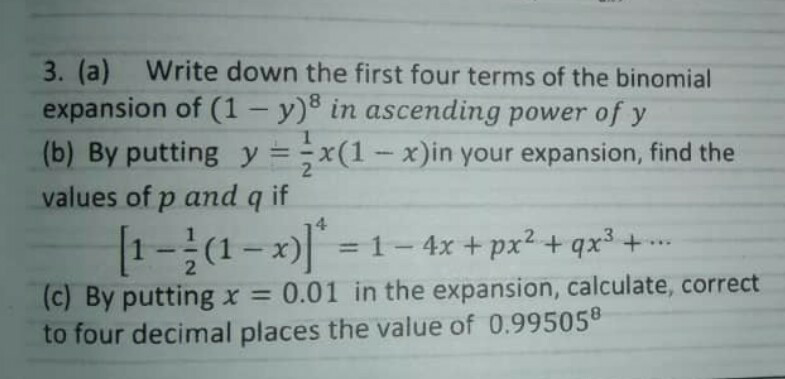
Question and Answers Forum
AllQuestion and Answers: Page 1640








Pg 1635 Pg 1636 Pg 1637 Pg 1638 Pg 1639 Pg 1640 Pg 1641 Pg 1642 Pg 1643 Pg 1644
|
Question and Answers Forum |
AllQuestion and Answers: Page 1640 |
| If f(x)=2x+1 g(x)=(√x)+3 h(x)=(1/2) then hog^2 of (2)=? |

|

|
| If ∫_0 ^1 e^(−x^2 ) dx = a , then find the value of ∫_0 ^1 x^2 e^(−x^2 ) dx in terms of ′a′ ? |
| calculate lim_(n→+∞) ((1+2+3+...+n)/(1+2^4 +3^4 +...+n^4 )) |
| calculate lim_(n→+∞) ((1 +2^2 +3^2 +....+n^2 )/(1+2^4 +3^4 +....+n^4 )) |
| calculate lim_(n→+∞) ((1+2^3 +3^3 +....+n^3 )/(1+2^4 +3^4 +...+n^4 )) . |
| calculate Σ_(k=1) ^n k^4 interms of n. |
| Three variables u,v and w are related such that u varies directly as v and inversely as the square of w. If v increases by 15% and w decreased by 10%, find the percentage change in u. |

|
| The radius of the largest circle which passes through (1,2) and (3,4) and lies completely in the first quadrant is A) 3 B) 2 C) (√6) D) 2(√5) I got the answer as 2 but the answer given is 2(√5). |

|

|

|
| solve for x: e^x + e^x^2 + e^x^3 = 3 + x + x^2 + x^3 |

|
| Find the area common to min{[x], [y] } =2 and max{[x], [y] } =4 . [x] denotes the greatest integer less than or equal to x. |
| ((√2) +i)(1−(√(2i)) ) |
| in a geometric series, the first term =a, common ratio=r. If S_n denotes the sum of the n terms and U_n =Σ_(n=1) ^n S_(n,) then rS_n +(1−r)U_(n ) equals to (a) 0 (b) n (c) na (d)nar |
| prove that ((2 cos 2^n θ + 1)/(2 cos θ + 1)) = (2 cos θ − 1)(2 cos 2θ − 1)(2 cos 2^2 θ− 1) ...(2 cos 2^(n − 1) θ − 1) |
| ∫_0 ^π (dx/(√(3−cos x)))= |
| Given the function f(x) where f(x)= { ((∫x^2 + 1 ,for {x:x D(f) 2)),((∫x^3 − 1,for y = f′(x))) :} a) Evaluate f(2) if f(a)= 2 + a^(n−1) find the value of a hence the domain of f(x). |
| ∫∫_R (2x + 3y)^2 dA=?? |

|
| letf(x) = ((2x+1)/((x−2)(x^2 +x+1))) 1) calculate f^((n)) (x) 2) find f^((n)) (0) 3) developp f at integr serie. ( |
| find the value of Σ_(n=2) ^∞ ((3n^2 +1)/((n−1)^3 (n+1)^3 )) |
Pg 1635 Pg 1636 Pg 1637 Pg 1638 Pg 1639 Pg 1640 Pg 1641 Pg 1642 Pg 1643 Pg 1644 |